
During the day, it’s a serene three-acre oasis with a 90-foot waterfall cascading into a pool of water, an 11-story high mountain and 1,500 pine trees. But like everything else in Las Vegas, it is not as it seems. Come sundown, the lights turn on and technology transforms this setting into a multimedia spectacle, The Lake of Dreams.
The Wynn Hotel’s attraction has enchanted its lakeside spectators since its opening in 2005. In 2018, Wynn general manager/producer Rick Gray spearheaded a new $14 million technology upgrade to launch in 2020. He brought together the original creative team of Emmy-winning director Kenny Ortega, production/puppet designer Michael Curry (known for his role in Broadway’s The Lion King) and lighting designer Patrick Woodroffe (Rolling Stones, Adele) along with video design director Gary Jaeger (CORE Studios) and sound designer Peter Hylenski (PH Sound Design) to reimagine the technology and the music for a new invigorated show. But as the production prepared for installation, the pandemic hit. The world shut down.
What happened next was off the charts. The attraction opened in October 2020 — coincidentally, outdoors and perfectly suited for socially distanced pandemic conditions. But what it took to get there was unprecedented in the live event industry. Now, the process is already serving as a procedural guidebook for future shows in this era of Covid-19.
PLSN checked in with lighting designers Patrick Woodroffe and Terry Cook of Woodroffe Bassett Design (WBD, www.woodroffebassett.com), lighting programmer Chris Lose, video programmer Evan Bloom and laser designer/programmer Lawrence Wright (from ER Productions) for the story-within-the-story about programming a production during the pandemic. And forget about the six feet of social distancing. This was 6,000-plus miles.

Animatronics, Orbs, Laser Animations and 5,500 LEDs
The show — held every half hour each night — is designed to blur the lines between technology and magic. The real magic is the fact that it opened at all during the pandemic.
Woodroffe explained his team’s role. “For our part, we planned to upgrade all the fixtures and then add two or three other layers of light in the form of extra color-changing LED PARs buried within the planting, a set of hand-sized LED pucks that were scattered randomly throughout the trees, and a full laser system. WBD partner Adam Bassett was responsible for the initial technical design, and he and Terry Cook made various visits to the site to initialize and then commission the new systems.”
The new systems tell a story through a series of segments with updated music.
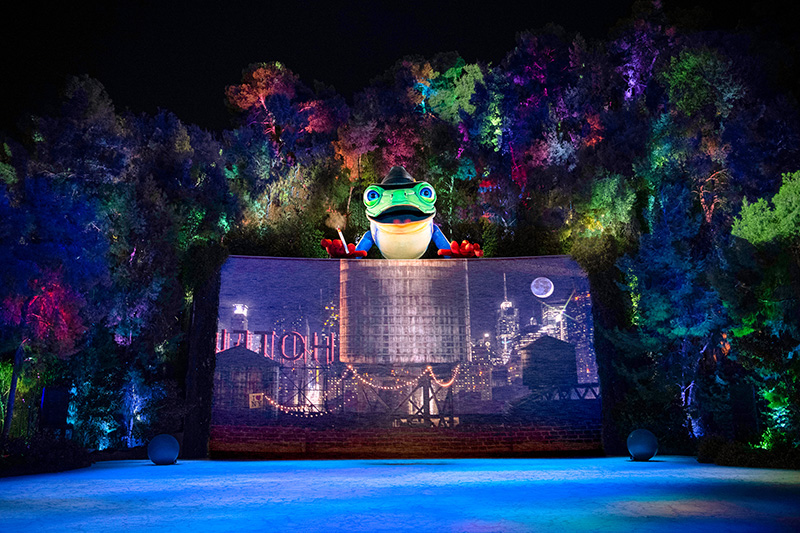
Michael Curry’s animatronics play a significant role. While the 30-foot Singing Frog returns with a makeover and advanced robotics singing Frank Sinatra’s “New York, New York,” the Lady Birds are new — a trio of 28-foot tall, 17,000-pound animated toucans who dance using dozens of computer-controlled servo motors during “Lady Marmalade.”
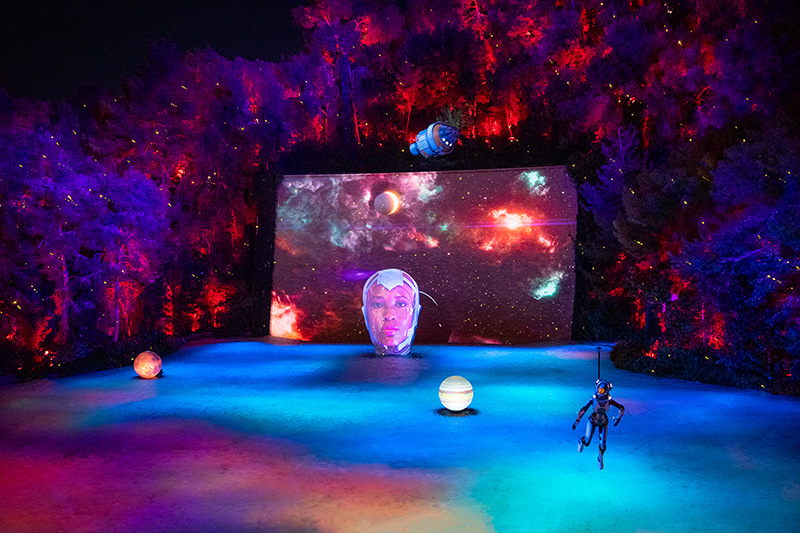
Astronaut is another new act, an animatronic puppet/space explorer who moves to a cover version of David Bowie’s “Space Oddity.” The spaceman is guided by Flying By Foy’s Invisible 3D flying system, whose wires are attached to the Wynn roof and mountain.
Another new Curry character is Electra, a shining star sculpture made up of hundreds of individually controlled RGBW LED pixels. As the show’s celestial emcee, the wireless star soars through the night addressing the audience at the opening and closing of the show.
The three color-changing Orbs, balls which glide on top of the water, are bigger and digitally updated as the Emoji Orbs. A Watchout media server inside each orb projects emoji faces to give the balls character for its whimsical love-on-the-lake segment during the song, “I Got You Babe.” Each orb is battery powered with a wireless signal, so there are no cables except guidelines that move it through the water. Now there’s a “shark” — a remote-controlled boat topped with a fin with a tracker tag to the Tait Navigator automation platform, then to the Green Hippo Hippotizer media server.
Even the waterfall is a performer. “It’s variable controlled,” Cook explained. “Behind the waterfall is a white travertine marble stone wall with pumps that reverse the flow of water, so it can be shut off instantly. We turn water off to help with the clarity of the video and use the wall as a projection surface.”
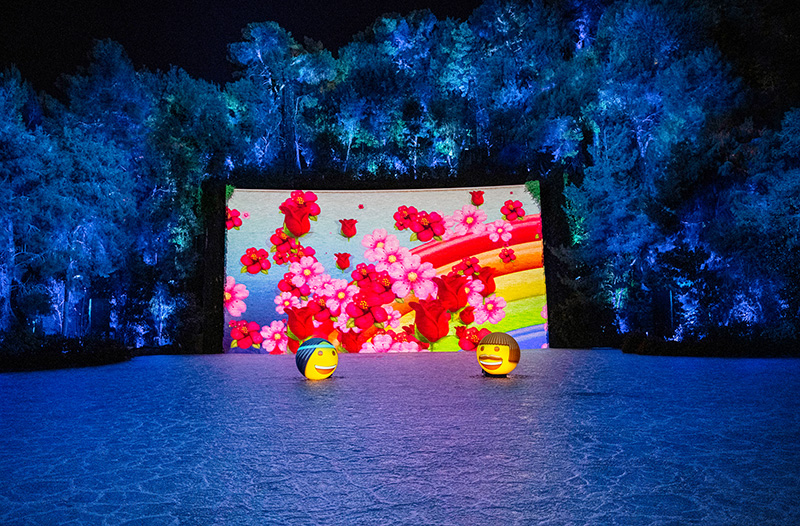
The pine forest also serves as a set for fireflies and blinking effects using 400-plus egg strobes, Claypaky B-Eyes, Color Kinetic LED Puck lights and GLP KNV Dots. The flashy LEDs “make it more fun and interactive and allowed for more inventive time code,” Cook noted. Some pucks dangle from branches while others are fixed onto fiberglass poles. Arborists were brought in to ensure no tree damage would occur from any of the light fixture installations.
One element remaining from the original design is the network of Color Kinetics LEDs. There are 4,000 individually controlled C-Splash 2 units attached on 700 panels on the bottom of the 4-foot deep lake to paint the water with color and effects. “It becomes a low-res video screen,” Cook explained. “There are newer products available, but it still works because the lights are balanced to the video, so we didn’t change it.”
They also swapped the Altman Lighting fixtures to a mix of Lumenpulse 2700K and RGBW LED units to lower the power cost, maintenance and fire risk. In total, more than 5,500 LED lights brighten up the night, all installed by PRG Las Vegas and Wynn Engineering.
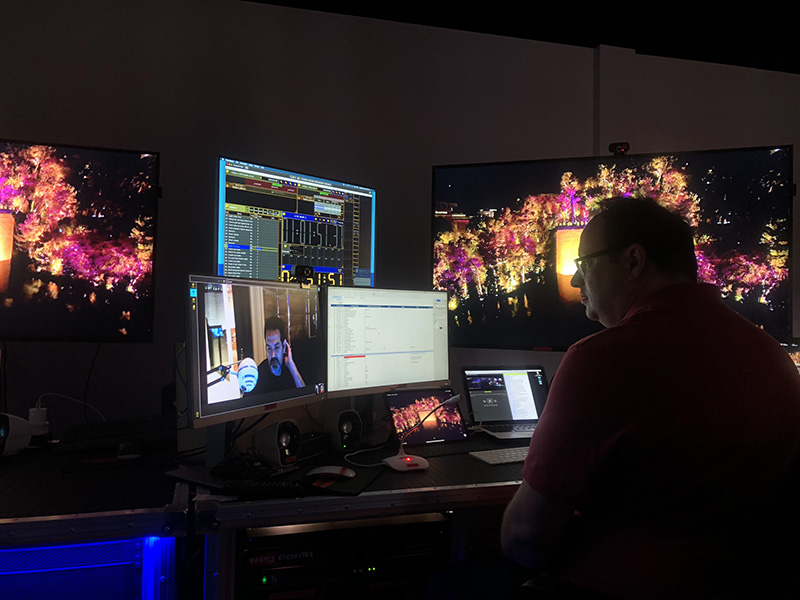
Lasers Add Sparkle to the Story
This isn’t a typical laser show, as ER Productions general manager Lawrence Wright explained: “Using the lasers for animations and graphics rather than a beam show was a unique use of the lasers, bringing the whole mountain to life instantly.”
The lasers project lyrics and animations onto the waterfall and mountain, such as during Lady Gaga’s song, “Born This Way.” Lasers also track and overlay video content to add sparkle to characters during The Swimmer, an underwater film sequence that follows a mythical mermaid.
ER installed a complete laser package of six Phaenon Pro X 30000, ER’s custom safety system and a Pangolin Beyond control package. As the lasers run in up to nine shows nightly, Wright chose the lasers for their reliability, beam quality, integrated effects wheel and remote management. Wynn’s grandMA2 console triggers the Pangolin Beyond laser software, either triggering cues or activating timelines to pick up timecode from their show controller system.
Wright’s team designed and tested the system for two years, with techs Katy Kruzic and Becky Prough helping with installation. Wright himself did not expect to program the show, but being based there in Las Vegas made it convenient. “Previous to taking this position, almost all my work was programming and touring,” he said. “It was nice to get back to that for a few weeks.”
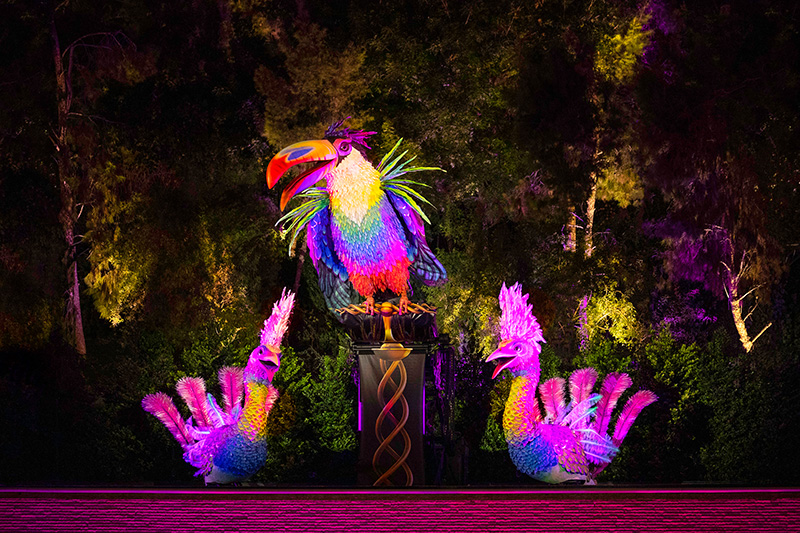
“Meticulous” Lighting Programming
Answering the call from WBD’s Terry Cook to travel from Lakeshore, Ontario, Canada to Las Vegas for programming, an “ecstatic” Chris Lose said, “For the first time, I was willing to reasonably risk my health for the sake of putting on a show.”
His first step was to update the Wynn’s console for a show that’s been running every night on older software for 15 years. While updating the grandMA2 and the NPUs from version 3.2.2.16 to the latest 3.9.0.3, “we had to hold our breath through each subsequent version,” Lose said. In doing so, he recognized many user profiles in the desk. “Some legends of the industry had a hand in making this show so magical. I was able to stand on their shoulders and reach for even greater heights.”
Programming was meticulous, as is expected of a time-synched show. Lose controlled Martin’s MAC Viper profile and wash units lighting from the front and ground areas and Claypaky B-Eyes in the trees. He also programmed the console running the Hippotizer media server.
Sometimes the unexpected got caught up in the signals. Lose explained, “We would get reports from the other side of the resort that lights were flashing with the music in the restaurant. It may have been a cool effect, but it was not intended. We had to hunt down obscure architectural channels and clone them to something more appropriate, or park them at a desirable level.”
In the end, he was satisfied with the result. “The most fulfilling part is knowing that it will delight so many people for years to come,” Lose said.
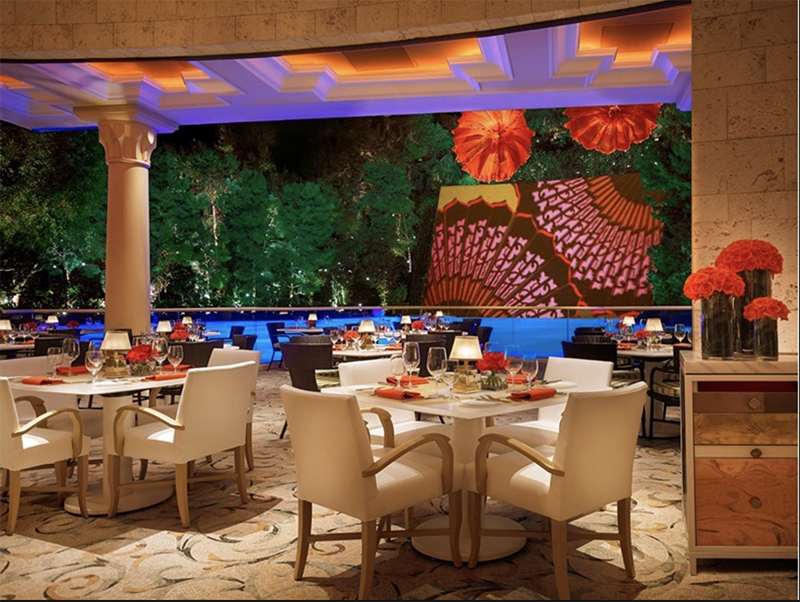
Media Server Magic
The inability for the spectators to discern what is real and what is technology is the magic of the show. Video programmer Evan Bloom used two media servers: a Green Hippo Hippotizer v4.5 using media clips to control all the LEDs in the trees and under the water; and Watchout in the orbs and on the waterfall to blur those lines of reality, using video content designed by Core Studios.
Many moments blur the lines, but one example can be seen during The Chainsmokers’ song, “Side Effects,” where video clips of people’s heads pop up from the lake and into the “waterfall,” which, because it was turned off, is not real water but a series of front projections of water controlled by Watchout.
Based in Las Vegas, Bloom didn’t have to travel far for the gig. Having worked on the Wynn project in previous years with PRG, he brought helpful experience to the production. While Wynn has an in-house staff to handle the nightly show, Bloom trained one to monitor the servers. “It was interesting to turn on the work engine again after six months of mostly sitting around,” Bloom said. “Getting back to doing a 10 to 12 hour day, you realized you hadn’t missed a beat. The Woodroffe Bassett team were fun to work with and had a creative eye. It was a good time.”
Pandemic Programming: London to Las Vegas
As the installation began, so did the outbreak of coronavirus. With the decision to continue on with the project, Woodroffe soon realized that travel restrictions would keep him and Cook in the U.K. during the important six-week period of programming in Las Vegas from August through September 2020.
“We needed to look at accurate live images in London from the Lake of Dreams in real time, and it was essential there should be little to no latency as these travelled 6,000-plus miles to London,” Woodroffe explained. “Any lag wouldn’t allow us to judge the timing of our cues, something that was so important as we worked to give the impression that the music and the visuals were working in perfect synchronization. But almost more importantly, we had to feel directly connected with the team in Las Vegas and feel able to communicate with them in exactly the same way that we would have if we had been sitting there at the edge of the lake. We knew that the project would live or die on getting this right.”
Lighting company Neg Earth created a safe space in their London studio for video conferencing. In the final setup, Woodroffe had a Microsoft Teams call monitor on his side of the desk — socially distanced from Cook— that linked to a camera providing a view of director Kenny Ortega, Michael Curry and Rick Gray. Video producer Gary Jaeger would sometimes join in from Northern California, as did sound designer Peter Hylenski from his upstate New York studio.
Cook’s similar setup was linked with lighting programmer Chris Lose, laser programmer Lawrence Wright and video programmer Evan Bloom. He could see the layout of Chris’ grandMA on a separate screen.
Back at the Wynn, the three programmers were set up on top of the Wynn’s lakeside restaurants in three FOH booths spaced apart for lighting, media servers and 4K projectors and lasers.
Right from the start, Cook said, “When building Cue 1, I realized I utterly relied on Chris to be my eyes. ‘How does the blue look’ or, ‘Is the tempo right?’ Chris was a vital part; he was our eyes and ears on the ground.”
Bloom noted, “I sat at a station at the FOH with the servers and MA that would go to Terry and Patrick, and when they got to the programming portions of the songs involving LEDs, I would advise them on how to manipulate them to get the effect they were looking for.”
Lasers were also tricky through the distance. Said Wright, “It’s probably the hardest way to program lasers and visually communicate with the designers, as lasers can flicker on camera. Bringing their vision to life and showing them became an exciting challenge, as some effects were strobing rather than being smooth. Terry and Patrick did a fantastic job in working with us remotely.”
Cook would then have the running cue sheet linked together on their laptops to keep track of overall progress. A final screen linked through to a HD recording system allowed them to work offline after they had closed down from Las Vegas. This system recorded four cameras and the grandMA cue list in to one record with imbedded audio so they could look back and see what was happening when.
“Our sessions would begin between 3 and 6 in the morning, depending on that night’s schedule in Las Vegas,” Woodroffe said. “Terry and I would greet each other with a cup of tea, say ‘Good morning’ or ‘Good evening’ to the team in Las Vegas, and then start to work!”
Cook added, “I would go to bed at 6 p.m. London time and get up at 2 a.m. I was living on Vegas time! A friend asked me jokingly how my jet lag was. I liked the structure of the day. My body got used to it, and I enjoyed it. The awkward part was the ‘hang up’ at the end of the day. You miss walking to the bar for a beer; there were no end-of-day experiences, which are so vital. It was more formal, no loose chat, and we missed that.”
After eight weeks of successful programming, the teams realized there is a future for using technology in this way to actually create shows. Woodroffe said, “We have just taken on another project using the same technique, this time in Macao. The only change we are making is to have a non-active lighting console and an example of each of the fixtures we are using with us at Neg Earth along with a programmer who can copy and mimic the work done by the local programmer in China. This gives us more control when working with an unknown team and allows us to better understand the color or feel of the cue we are creating.”
The ultimate irony, Cook pointed out, came down to this: “Who would have known we created a show 15 years ago that would be perfect for our socially distanced time right now?”
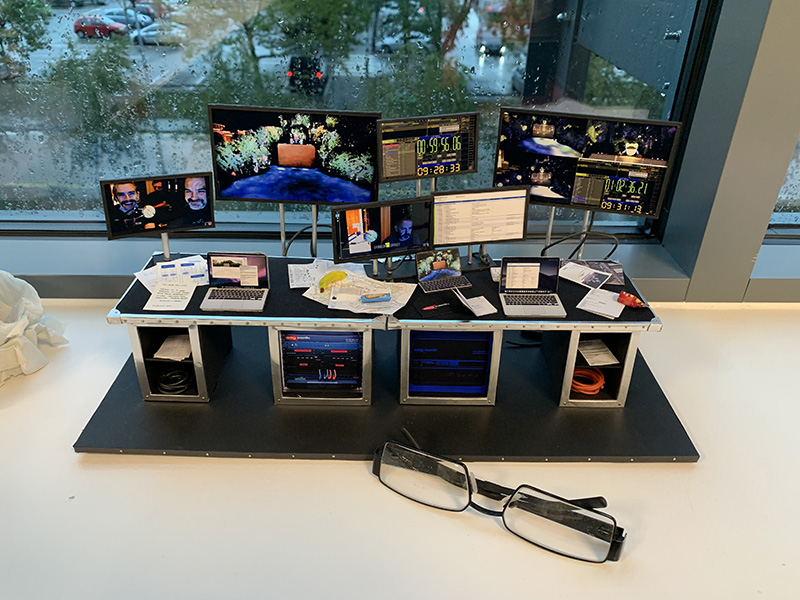
Credits for Wynn Las Vegas’ New “Lake of Dreams”
Creative Team:
- Director: Kenny Ortega
- Producer, Wynn Las Vegas: Rick Gray
- Production Designer: Michael Curry/Michael Curry Design
- Creative Director, Media: Gary Jaeger/CORE Studios
- Lighting Designers: Patrick Woodroffe and Terry Cook/Woodroffe Bassett Lighting Design
- Sound Designer: Peter Hylenski/PH Sound Design
- Orb Video Systems Design: Josh Weisberg/WorldStage
For Michael Curry Design:
- Technical Director: Sam Perkins
- Animatronics Art Director: Charles Babbage
For CORE Studios:
- Animation Director: Allen Donhauser
- Technical Director: Dylan Gallup
For Woodroffe Bassett Lighting Design:
- Associate Lighting Designer and System Design: Adam Bassett
- Studio support: Miriam Bull
- Lighting Programming: Chris Lose
- Laser Programming: Lawrence Wright
For PH Sound Design:
- Associate Sound Design: Simon Matthews
For WorldStage:
- Project Manager: Gabriel Weisberg
- System Designer: Marcus Garfunkel
For Entertainment Project Services:
- Project Manager: Steven Michelman
- Project Manager: Tyler Grady
For Wynn Las Vegas:
- Production Manager: Matt Scherbring
- Systems Manager: David Russell
- Lead Engineer: Dan Peters
- Lead Engineer: James Murchie
For a behind the scenes video of Wynn’s Lake of Dreams, scroll to “Behind the Waterfall: Creating the New Lake of Dreams” at www.plsn.me/WynnLake


